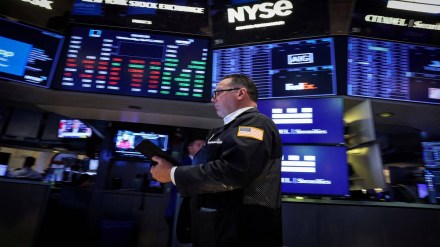Rumours of President Donald Trump considering a “90-day tariff pause” emerged on downtown Manhattan’s Siebert trading floor around 10:10 am ET following days of US market crash. Just seconds later, Mark Malek, the firm’s chief investment officer, witnessed a dramatic rise in stocks. With the morning in the S&P 500 out of sight, numbers grew as much as 3.4%, according to Bloomberg.
What incited this shocking plot twist? A social media post appeared to have rung in a good news alarm. Traders instantly fell for the X post that read, “HASSET: TRUMP IS CONSIDERING A 90-DAY PAUSE IN TARIFFS FOR ALL COUNTRIES EXCEPT CHINA.” Reposts for the same also gained traction subsequently while stocks embarked on an upward journey.
Fake news on Trump tariff pause wreaks havoc on US stock market
Shortly after the dramatic turn of events set in place, leading US news outlets, including CNBC and Reuters, clocked the so-called news flash. According to The Kobeissi Letter, the S&P 500 added over $3 trillion in market cap by 10:18 am ET.
However, just as quickly as the “tariff pause” sham had blown up, it dissipated into thin air with reports of “fake news” finally pouring in. At 10:34 am ET, the White House broke silence on the not so long-lived good news that appeared to quote Kevin Hassett, the National Economic Council director. Major outlets that had previously reported the issue swiftly pushed out edits and admitted to having fallen prey to the incorrect headlines.
What just happened?
— The Kobeissi Letter (@KobeissiLetter) April 7, 2025
At 10:10 AM ET, rumors emerged that the White House was considering a "90-day tariff pause."
At 10:15 AM ET, CNBC reported that Trump is considering a 90-day pause on tariffs for ALL countries except for China.
By 10:18 AM ET, the S&P 500 had added over +$3… pic.twitter.com/MtETHanUcl
How did the Trump tariff ‘fake news’ blow up?
The National Economic Council director was recently asked whether President Trump would consider pausing his tariff regime. “I think the president is going to decide what the president is going to decide,” he said on Fox News.
Soon after his response, Walter Bloomberg, a popular X account, pushed a social media post, insisting that Hasett had confirmed Trump weighing a 90-day pause in tariffs. Minutes after that, Carl Quintanilla, a CNBC anchor read the headline on air. And then, Reuters also went ahead with the headline.
Although the Walter Bloomberg account deleted the post, they told The New York Times via an X message that their post only came second to another one. “Given the market movement — plus 4.5 percent — I deemed the headline reliable and posted it at 10:13,” the account said. “A few minutes later, Reuters picked up the story.”
Traders after the stock market rollercoaster
What followed thereafter was pure “madness,” as Peter Tuchman, senior floor trader at TradeMas (New York Stock Exchange) aptly put it. “Everything sold off” the minute traders realised that claims of Trump reconsidering dumping the tariff rollout were nothing more than false hope. All said and done, the entire rollercoaster ride lasted merely 15 minutes — 900 seconds that witnessed not only the stock sharply soar and plunge, but also traders’ emotions erupt in a whirlwind.
By the end of the history-making and unsettling shocker, the S&P 500 washed out more than $2 trillion of market cap from its high. Justin Wiggs, a managing director in equity trading at Stifel Nicolaus, called the “velocity of the moves… just staggering.” He added, “It felt swifter than anything I ever experienced during Covid and the financial crisis on a trading desk.”
Bridgewater’s billionaire Ray Dalio noted that it’s not all about the tariffs. “Don’t make the mistake of thinking that what’s now happening is mostly about tariffs,” he posted on X.
He pointed out on social media that while a lot of attention was being paid to the tariffs announcement, “very little attention is being paid to the circumstances that caused them and the biggest disruptions that are likely still ahead.” Detailing these “important forces that are driving just about everything, including the tariffs,” he said, “The far bigger, far more important thing to keep in mind is that we are seeing a classic breakdown of the major monetary, political, and geopolitical orders. This sort of breakdown occurs only about once in a lifetime, but they have happened many times in history when similar unsustainable conditions were in place.”
https://t.co/Xpdl8fYoBg
— Ray Dalio (@RayDalio) April 7, 2025
His lengthy article dove deeper into the consequences of five “big forces and their interrelationships,” which are, in turn, causing the “Overall Big Cycles changes.” These are:
- Monetary/economic order breaking down due to too much existing debt.
- Domestic political order breaking down due to huge gaps in people’s education levels, opportunities, productivities, income and wealth and values.
- International geopolitical world order breaking down as the era of “one dominant power,” i.e. the US dictating the order other countries follow is over.
- Acts of nature (droughts, floods, pandemics) are increasingly disruptive.
- Changes in technology as AI to become highly impactful to all aspects of life.
